| Article ID | Journal | Published Year | Pages | File Type |
|---|---|---|---|---|
| 8166270 | Nuclear Instruments and Methods in Physics Research Section A: Accelerators, Spectrometers, Detectors and Associated Equipment | 2018 | 29 Pages |
Abstract
Current PET detectors have a very low sensitivity, of the order of a few percent. One of the reasons is the fact that Compton interactions are rejected. If an event involves multiple Compton scattering and the total deposited energy lays within the photoelectric peak, then an energy-weighted centroid is the given output for the coordinates of the reconstructed interaction point. This introduces distortion in the final reconstructed image. The aim of our work is to prove that Compton events are a very rich source of additional information as one can improve the resolution of the detector and implicitly the final reconstructed image. This could be a real breakthrough for PET detector technology as one should be able to obtain better results with less patient radiation. Using a PET as a double Compton camera, by means of Compton cone matching i.e., Compton cones coming from the same event should be compatible, is applied to discard randoms, patient scattered events and also, to perform a correct matching among events with multiple coincidences. In order to fully benefit experimentally from Compton events using monolithic scintillators a multi-layer configuration is needed and a good time-of-flight resolution.
Keywords
Related Topics
Physical Sciences and Engineering
Physics and Astronomy
Instrumentation
Authors
V. Ilisie, V. Giménez-Alventosa, L. Moliner, F. Sánchez, A.J. González, M.J. RodrÃguez-Álvarez, J.M. Benlloch,
